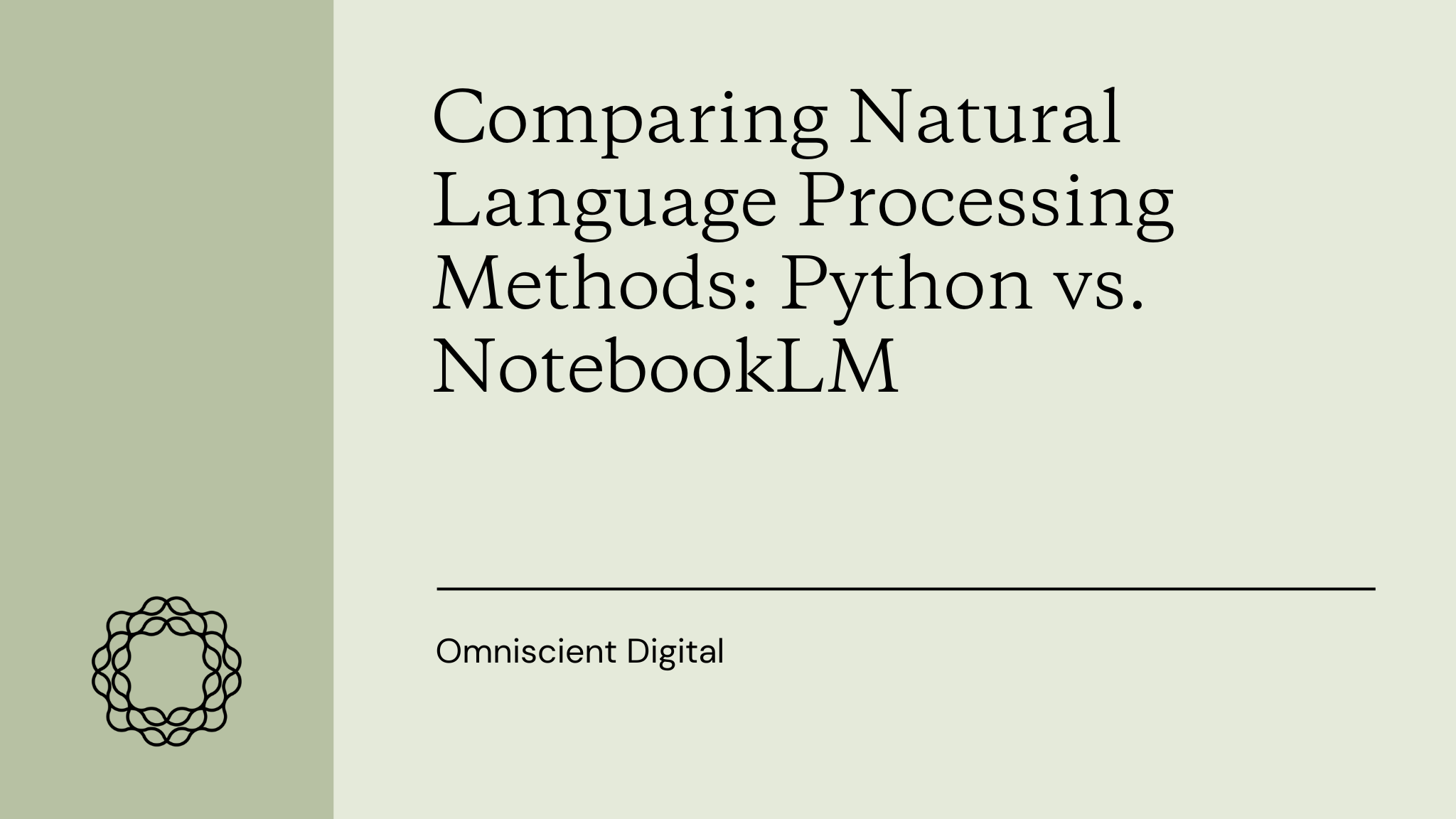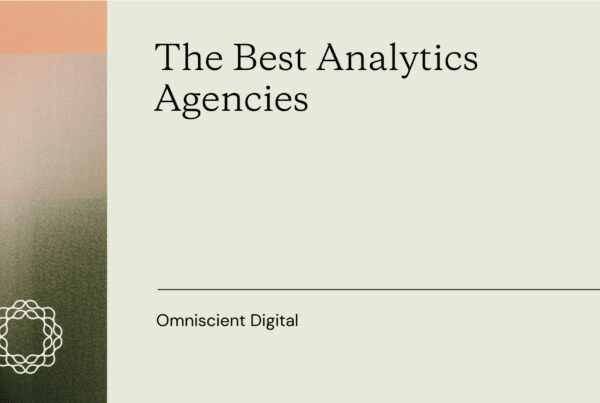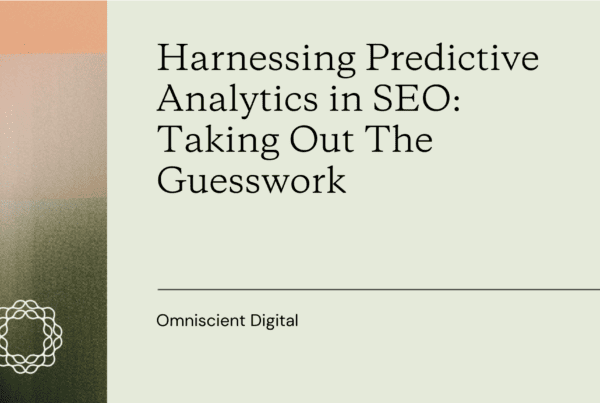
I recently analyzed twenty 30-minute interviews with marketing leaders to understand their perspectives on organic growth. This analysis turned into a research report, Signals in the Noise.
The data I worked with was rich, unstructured, and followed disparate formats, presenting challenges in qualitative analysis.
To quickly and effectively analyze these transcripts, I tested two approaches: traditional Natural Language Processing (NLP) using Python and Google’s AI tool, NotebookLM.
Here is how these methods compare to manual processing, considering three critical factors for marketers and data analysts: speed, skill, and quality.
| Method | Time to Value | Skills Needed | Insight Quality |
| Manual Analysis | Poor | Beginner | Excellent |
| Python NLP | Moderate | Advanced | Moderate |
| NotebookLM | Excellent | Beginner | Excellent |
My Experience with NLP in Python
Initially, I thought Python was the clear choice. Having familiarity with it, I began with topic modeling techniques such as Latent Dirichlet Allocation (LDA) and BERTopic. Here’s what I discovered:
Lesson 1: Standardize interview formats upfront.
I imported all 20 .docx transcripts into a DataFrame and started preprocessing by removing timestamps, line breaks, trailing spaces, and converting all text to lowercase. However, I quickly realized I overlooked a crucial issue: my team produced transcripts in four different file formats due to varied recording tools, which complicated the preprocessing.
Python struggled to differentiate between questions and answers, negatively affecting the accuracy of topic modeling. To resolve this, I ended up writing four different preprocessing scripts to manage each format individually.
Below are two different examples of what the transcripts looked like, showing how the format affects Python’s ability to decipher a question vs. an answer:
Lesson 2: Spoken language creates significant noise.
The natural use of filler words (like “yeah,” “hey,” “like,” or interviewer names) greatly disrupted clarity. I manually expanded my stop-word list from 20 to 178, yet clarity never improved.
Lesson 3: Heavy preprocessing lowers Python’s ROI.
I knew some text cleaning would be needed, but I expected a straightforward modeling process afterward. Unfortunately, even after thorough preprocessing, my topic outputs remained unclear and lacked a coherent story.
For example, initial LDA outputs looked something like:
Topic 1:
[‘years’, ‘video’, ‘little bit’, ‘leadership’, ‘folks’, ‘money’, ‘better’, ‘channel’, ‘blog’]
Topic 2:
[‘looking’, ‘quarter’, ‘tracking’, ‘challenge’, ‘organic growth’, ‘build’, ‘gap’]
Topic 3:
[‘linkedin’, ‘touch’, ‘sales’, ‘attribution’, ‘portfolio’, ‘organic growth’, ‘stage’]
Even advanced preprocessing with BERTopic mostly surfaced noisy, irrelevant clusters:
Example: [‘new york’, ‘see’, ‘great’, ‘would’, ‘love’, ‘im always’, ‘youll fine’]
Overall, I gave Python a fair shot at topic modeling, referencing others’ code on GitHub and Stack Overflow, as well as using ChatGPT to help. Seven hours of debugging later, I still lacked a storyline.
The actual model running the topic modeling is only a few short lines of code. The devil is in the preprocessing. Even with great results, I couldn’t necessarily re-use this same code again for different interviews.
For most marketing teams, Python NLP is too slow for day-to-day insight mining.
My Experience with NotebookLM
Realizing Python wasn’t delivering the insights I needed, I shifted to NotebookLM, Google’s AI tool specifically designed for text analysis. This tool massively simplified the process and allowed me to pull insights that told a clear story. Here’s what I learned:
Lesson 1: NotebookLM lets you skip the tedious preprocessing.
With this tool, I simply uploaded the documents directly, moved straight into the chat-based exploration, and created a studio to pin notes and key ideas.
In the chat box, there are suggestions for questions to ask, as well as a quick summary of the data, generated for you at the top.
I started by looking at the key points in the summary and asking questions that related to the overarching topics. NotebookLM pulls direct quotes related to the topic at hand and will give specific statistics on the respondent’s opinions.
Lesson 2: NotebookLM helps you build a cohesive narrative.
I kept exploring a topic deeply until responses started repeating, indicating I’d captured all relevant insights. Within the same seven hours previously spent wrestling with Python, NotebookLM helped me clearly identify and synthesize 18 meaningful subtopics, enabling me to craft a compelling story from my interviews.
While asking multiple questions and reading the responses manually took time, I had a vision for where I was going and felt like I truly understood the data. I grouped together my subtopics into a report that clearly outlined how AI is impacting organic growth, how these companies are using data, and what they wish they could implement to strengthen their teams.
Lesson 3: NotebookLM is accessible for anyone.
NotebookLM didn’t require coding skills, complex scripts, or technical expertise. There is no need to spend time learning Python or playing ping-pong with ChatGPT to get your query to work. Even non-analysts can directly jump into extracting insights, significantly speeding up the analysis process for busy teams.
As I put together my report with this tool, two prominent themes from my interviews emerged clearly: marketing leaders know they’re underusing AI and their proprietary data. NotebookLM directly addresses both gaps, allowing marketing teams to pull insights from data without the pain points of traditional analysis.
Summary Comparison
| Criterion | Python NLP | NotebookLM |
| Setup time | 5–10 hrs | 15 min |
| Skill needed | Data analyst | Any marketer |
| Strength | Fine‑grained control | Speed & narrative |
| Weakness | Heavy preprocessing | Limited custom metrics |
| Use if… | You need replicable code for thousands of docs | You need insights tomorrow |
If you are a marketer wanting to analyze text data in the most efficient and effective way, start with NotebookLM and implement Python workflows only when you need reproducible code for a larger scale of projects. Its ability to deliver insights in hours over days will give you an advantage to advance your team’s data analysis without demanding coding skills.


